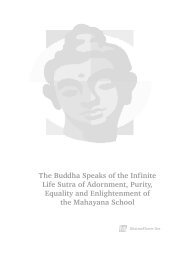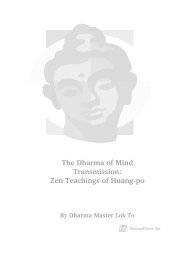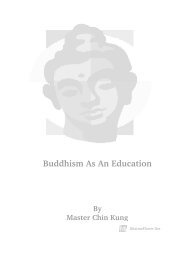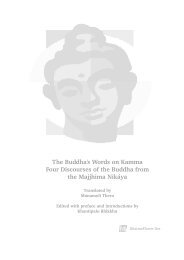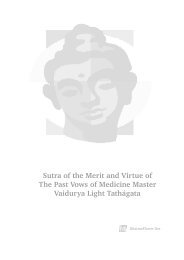Vipassana Meditation : Lectures On Insight Meditation by Venerable
Vipassana Meditation : Lectures On Insight Meditation by Venerable
Vipassana Meditation : Lectures On Insight Meditation by Venerable
Create successful ePaper yourself
Turn your PDF publications into a flip-book with our unique Google optimized e-Paper software.
knowledge, wisdom or intelligence, and tends to believe easily any theory ordoctrine. If a meditator is credulous, he may fall into a doctrine or theory,which leads to the wrong path. Therefore, saddha must be in balance withpaññá, knowledge or wisdom. In this way, Saddhindriya and Pannindriya mustbe in balance.Then again, samádhi (concentration) and viriya (energy) must be inbalance. If viriya is more powerful and stronger than samádhi, you cannotconcentrate well on the object of meditation. The commentary says: If virzya isstronger or more powerful than samádhi, a meditator's mind will becomedistracted and restless (uddhacca).In the beginning of the practice his concentration is usually weak and oftenwanders. So, he should follow the mind and watch it as it is. If a meditator isenthusiastic for the achievement of insight, he may put too much effort in hispractice, there<strong>by</strong> causing the mind to become distracted and restless. Effortmust be kept in balance with samádhi. To do this, he must reduce his effort,keeping his mind stable and steady; noting whatever arises in his mind andbody attentively, but not too energetically. Then he will gradually attain somedegree of concentration. Because of this concentration, his effort will becomesteady and firm, neither too strong nor too lax.In some cases when a meditator has practiced meditation for two or threeweeks, his concentration becomes very deep and strong, the noting mind notesthe object <strong>by</strong> itself, automatically and effortlessly. If, however, insufficienteffort is put in, the noting mind will gradually become dull and heavy. Hence,that concentration changes into sloth and torpor or sleepiness. Thecommentary says: -If concentration is too strong and effort is too weak, then thatconcentration changes into sloth and torpor or sleepiness (thina-middha).So concentration must be kept in balance with effort (viriya). The passiveposture of sitting will only make his mind more concentrated on the objectand, as less and less effort is required, the mind will become more and moredull. To keep his concentration in balance with effort, he should practicewalking meditation longer than sitting. However, only very few meditatorsexperience concentration that exceeds effort. There are also some meditatorswhose effort exceeds their concentration. Therefore, concentration must bekept in balance with effort, depending on circumstances.According to the commentary, we can never say that sati is too strong orpowerful because it is best for you to be mindful of each and every activity ofmind and body from moment to moment. Then mindfulness becomes constant,sustained, uninterrupted and continuous, there<strong>by</strong> giving rise to deepconcentration. When concentration is deep, insight will unfold naturally andyou will be able to realize the mind and body processes (nama and rupa). So,we can say that mindfulness is never too strong or powerful.40



